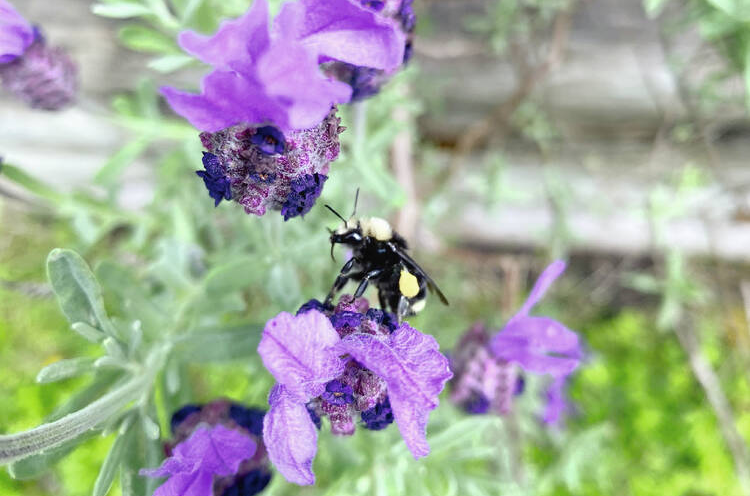The provincial apiculturist says bee die-offs this spring are due to the prolonged cool weather and have nothing to do with the recent aerial spraying for spongy moths.
Paul van Westendorp said adult bees first out of the hive every spring are opportunistic and follow the pollen for the greater good of their hive. “They go full throttle, maximum speed in their search for food,” he said. “And they work in synch with food availability and quality.”
But when the first round of pollen is finished in flowering plants like dandelions and blueberries, die-offs happen. More bees await the next round of pollen-rich plants, which includes blackberries, fruit trees and flowering plants.
“I get calls every spring with people saying look at all these dead bees,” said van Westendorp. “But when we have unwelcome cold and rainy weather, bees can overextend themselves as a unit. Adults sacrifice themselves to get food for the brood.”
Social-media reports that the bees were killed by spraying for the spongy moth — formerly called gypsy moths — are unfounded, said van Westendorp.
Aerial spraying of the biological insecticide Foray 48B by the Forests Ministry began in April and continues this month over wide swaths of the province — including areas from Greater Victoria to Salt Spring Island and Qualicum Beach.
Van Westendorp said the insecticide affects only moth and butterfly caterpillars after ingestion. The active ingredient — bacillus thuringiensis variation kurstaki, or BTK — is a natural bacteria found in soils and affects only insects with high-alkaline digestive systems.
It’s non-toxic to humans and bees because “we have acidic digestive systems,” said van Westendorp.
When BTK is ingested by a caterpillar, the highly alkaline environment of the caterpillar’s gut triggers the BTK bacterium to release a crystalline protein called an endotoxin that poisons the insect’s digestive system.
“BTK has zero impact on bees,” he said.
BTK has been approved for use against spongy moth larvae in Canada since 1961.
Spongy moth caterpillars feed on tree leaves and have defoliated sections of forests and residential areas in Ontario and the eastern United States in recent years, according to the Forests Ministry.
Up to 300 species of trees and shrubs can be affected, including Garry oak, arbutus, red cedar, maple and fruit trees.
The moths have spread to B.C. on vehicles and equipment, and in 2021 were found to have increased dramatically in View Royal, Nanoose Bay and Cowichan Lake, as well as in the Fraser Valley and the Lower Mainland.
Bee die-offs are common in the spring and usually happen because of the weather, said van Westendorp. If flowering is delayed, they stay put. But when they appear, the bees get busy. “Honeybees have a perennial nest, so there is a steady turnover,” he said.
Honeybees only live six to eight weeks in the summer and 20 weeks in the winter months, although the queens can live up to five years.
Mason bees, which are the solitary variety and common here, are just finishing up their pollen seasons and going back into the hives. Van Westendorp said those with mason bee wood-block hives can put them into breathable plastic bags and store them in a cool, dry place to protect them from parasites.
Meanwhile, van Westendorp said there have been no early sightings of the northern giant hornet in B.C. or Washington. Formerly called the Asian giant hornet and sometimes referred to as the murder hornet, Vespa mandarinia was first discovered in Canada in Nanaimo in 2019, when a single nest was destroyed.
Sporadic captures ensued and a large nest was taken out near the Canadian border in Blaine, Washington in 2020. The large hornets have been known to wipe out entire bee colonies and pack a powerful sting on humans.
While the northern giant hornet seems to be under control, another invasive hornet could be coming, van Westendorp said.
The Vespa velutina, or Asian yellow-legged hornet, which occurs naturally from Afghanistan to eastern China and Indonesia, has been expanding its territory over the past two decades to South Korea, Japan and Europe.
Like their larger Asian cousins, the yellow-legged hornets prey on honeybees, but they have much larger nests capable of housing up to 6,000 that are built high in tree canopies, which make them harder to control, said van Westendorp.
The yellow-legged hornets have a foothold in North America. Nests were found in Savannah, Georgia last September. Like most invasive insects, including the northern giant hornet, they are believed to have hitchhiked aboard cargo ships.
“The Europeans have spent millions trying to get rid of them,” said van Westendorp. “It’s just a matter of time before they end up in Canada.”
>>> To comment on this article, write a letter to the editor: [email protected]



